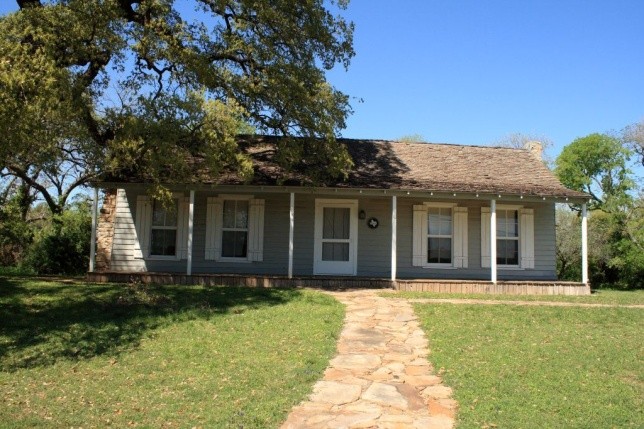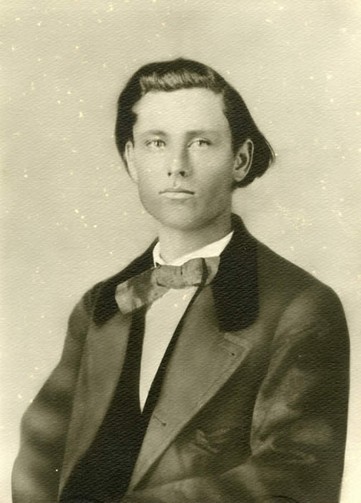Van Zandt Cottage
Introduction
Text-to-speech Audio
Located in the heart of Fort Worth, near Trinity Park, the Van Zandt Cottage is Fort Worth's oldest home still located at its original location. The rustic cottage dates back to the mid 1800s, and was owned by one of the city's most prominent pioneers. The Cottage is listed on the National Register of Historic Places, and is a fine example of a pre-railroad-era dwelling.
Images
Van Zandt Cottage Today.

Photo of K.M. Van Zandt during the Civil War.

Backstory and Context
Text-to-speech Audio
The Van Zandt cottage was home to one of the all-time most influential citizens of Fort Worth, K.M. Van Zandt. Throughout his life, Van Zandt achieved a great deal of success. He was a cattleman, a member of the Texas Legislature, a banker, and a merchant.1
Khleber Miller (K.M.) Van Zandt was born on November 7th, 1836 in Franklin County, Tennessee. Isaac van Zandt, his father, soon moved the family to Texas, where he was appointed to help the United States government oversee the annexation of the Republic of Texas.2 Soon after, K.M. went of to Franklin College in Tennessee. He graduated in July of 1854 and headed back to Texas.3
K.M. Van Zandt fought for the Confederacy during the Civil War, and saw the devastating effect that the war had on his beloved state. K.M. was a critical part of Company D, Texas Seventh Regiment for the Confederate Army.4 Van Zandt organized the company, and was one of the most heroic and brave fighters in the South.
Once the war ended, K.M. set out to achieve his dream--moving to "west Texas." By this time, Van Zandt had risen to the rank of "Major" in the Confederate states, a rank that he would carry for the rest of his life. In 1871, Major Van Zandt bought a small plot of land near present day downtown Fort Worth--a plot that would soon become the sight of many historic moments in Fort Worth.
Van Zandt's small parcel of land contained a small cottage--what is today know as Van Zandt Cottage. Over the years, Van Zandt acquired more than 600 acres of prime Fort Worth real estate, land he used to raise his fourteen (14) children.
Van Zandt played a pivotal role in forming Fort Worth, serving many roles. In 1866, Van Zandt held start the first school post Civil War. In 1872 Van Zandt brought the Texas and Pacific Railroad to Fort Worth-- a railroad that remains a critical part of the Fort Worth economy to this day. Van Zandt served on the Fort Worth City Council, and as Treasurer of Fort Worth.
The Cottage itself has undergone many changes over the years. Unfortunately, not all of the restorations done have been authentic, and have significantly changed the facade and structural elements of the cottage.5
The Cottage, however, stands as a testament to the tenacity and strong-will of the pioneers who created the west, and of the extraordinary accomplishments of K.M. Van Zandt.
Khleber Miller (K.M.) Van Zandt was born on November 7th, 1836 in Franklin County, Tennessee. Isaac van Zandt, his father, soon moved the family to Texas, where he was appointed to help the United States government oversee the annexation of the Republic of Texas.2 Soon after, K.M. went of to Franklin College in Tennessee. He graduated in July of 1854 and headed back to Texas.3
K.M. Van Zandt fought for the Confederacy during the Civil War, and saw the devastating effect that the war had on his beloved state. K.M. was a critical part of Company D, Texas Seventh Regiment for the Confederate Army.4 Van Zandt organized the company, and was one of the most heroic and brave fighters in the South.
Once the war ended, K.M. set out to achieve his dream--moving to "west Texas." By this time, Van Zandt had risen to the rank of "Major" in the Confederate states, a rank that he would carry for the rest of his life. In 1871, Major Van Zandt bought a small plot of land near present day downtown Fort Worth--a plot that would soon become the sight of many historic moments in Fort Worth.
Van Zandt's small parcel of land contained a small cottage--what is today know as Van Zandt Cottage. Over the years, Van Zandt acquired more than 600 acres of prime Fort Worth real estate, land he used to raise his fourteen (14) children.
Van Zandt played a pivotal role in forming Fort Worth, serving many roles. In 1866, Van Zandt held start the first school post Civil War. In 1872 Van Zandt brought the Texas and Pacific Railroad to Fort Worth-- a railroad that remains a critical part of the Fort Worth economy to this day. Van Zandt served on the Fort Worth City Council, and as Treasurer of Fort Worth.
The Cottage itself has undergone many changes over the years. Unfortunately, not all of the restorations done have been authentic, and have significantly changed the facade and structural elements of the cottage.5
The Cottage, however, stands as a testament to the tenacity and strong-will of the pioneers who created the west, and of the extraordinary accomplishments of K.M. Van Zandt.
Sources
1. Roberts, John, AIA. "Van Zandt Cottage." Architecture in Fort Worth. 2015. Accessed July 27, 2016. http://www.fortwortharchitecture.com/cd/vanzandt.htm.
2. "Van Zandt Cottage." Van Zandt Cottage. Accessed July 27, 2016. http://www.logcabinvillage.org/vanzandtcottage.html.
3. Ibid.
4. Roberts, John, AIA. "Van Zandt Cottage." Architecture in Fort Worth. 2015. Accessed July 27, 2016. http://www.fortwortharchitecture.com/cd/vanzandt.htm.
5. "Recent Listing - Van Zandt Cottage." Texas Historical Commission. Accessed July 27, 2016. http://www.thc.texas.gov/preserve/projects-and-programs/national-register-historic-places/van-zandt-cottage-recent-listing.
